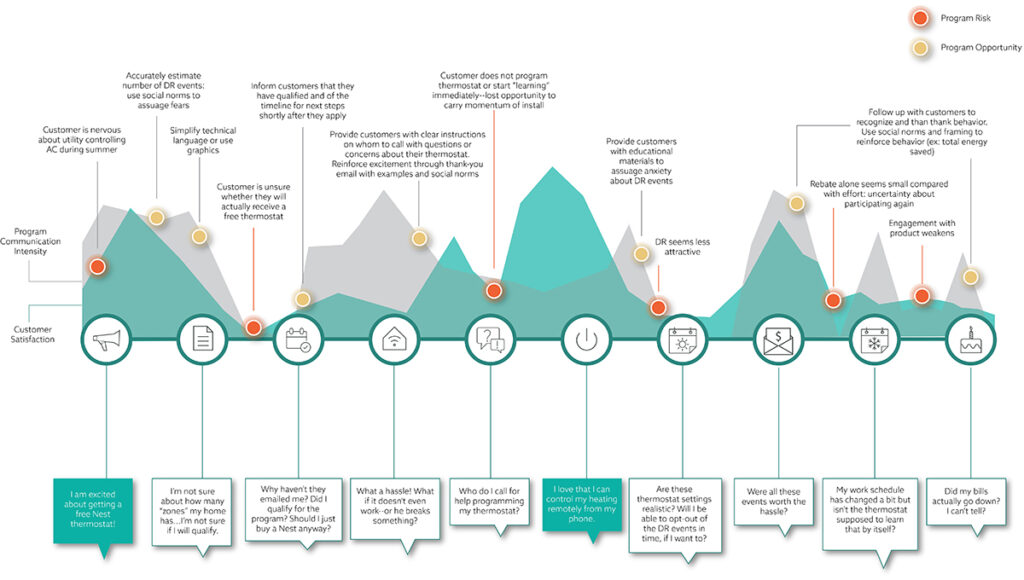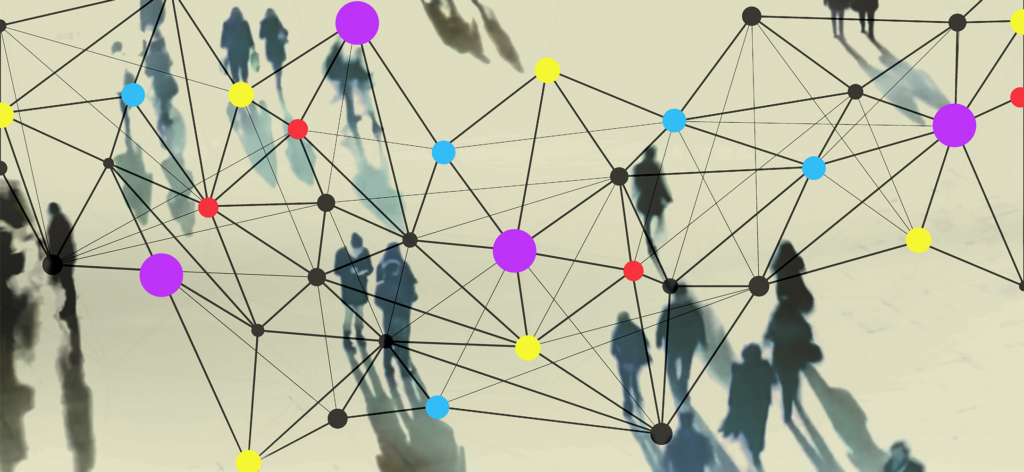Customer journey mapping is creating a visual depiction of the customer journey that is easy to understand and accessible across your organization. This visualization maps out every step a customer will take from discovery to purchase to continued loyalty. The customer journey map provides you with an understanding of who your customers are and what their different journeys look like. When deciding on marketing strategy, the customer journey map can help you determine the most beneficial way to engage with customers.
Data-driven marketing strategies are becoming increasingly important, and understanding customer needs is vital for your business to succeed. With the myriad touchstones an individual customer has during the customer journey, mapping that journey in a readable way becomes important. A customer journey map can help your business make the most out of incoming customer feedback and keep your business agile in the face of change.
Benefits of Customer Journey Mapping
Customer journey mapping can help your business grow and improve customer retention by tailoring individual customer experience. With proper customer journey management, your business can achieve financial benefits and improve customer satisfaction. Whether your business is business-to-business (B2B), business-to-consumer (B2C), or direct-to-consumer (DTC), you can benefit from a customer journey map.
1. Customer Journey Mapping Can Help Your Business Grow
The key to growing your business is taking every potential customer through the journey from potential customer to loyal customer. Different kinds of customers have different goals and needs for your business to address. A brand-new customer looks quite different from a customer who is already your biggest fan, and their journeys are therefore different.
The customer journey map provides insight into customer experience based on a specific customer persona. On a large scale, the consistency of this pipeline provided by a good customer journey map can lead to business growth.
2. Customer Journey Mapping Increases the Likelihood of Repeat Customers
The customer journey map also helps improve customer retention. A good customer journey map does not end with a sale. Instead, it considers steps for creating a consistent and ongoing relationship with customers. This customer interaction can be via email, phone call, or survey software after an online purchase. The journey map can provide useful information on customer needs from a customer perspective in each phase and further improve customer retention through more precise targeting.
3. Customer Journey Mapping Can Improve Your Business’s Bottom Line
The customer journey map provides a centralized resource for members of your organization to understand each step of the customer journey. Without a customer journey map, the customer interaction is fragmented between marketing, sales, and other touch points. In a research survey by global marketing technology and services firm Ansira, 32 percent of respondents found decentralized data was a barrier to success.
Your customers interact with your business across several touch points during their journey. Proper customer journey management can ensure each interaction is positive and meets customer needs. The better the customer experience, the more likely a customer is to return, which helps improve your bottom line.
Customer journey mapping for different audiences can also help improve targeting and reduce unnecessary ad spend. For example, marketers can suppress or activate different messaging based on certain audience attributes, ensuring only the most relevant content is delivered, through the right channel, at the right time.
The Customer Journey Mapping Process
The process of creating a customer journey map can start with a journey map template, and rather than ending, continue as an iterative process that you adjust over time to meet your business’s needs. The mapping process is different for different customer needs, and there are four major types of customer journey maps you can use. Whether you want a current-state journey map or a service blueprint journey map, many of the steps you should take in creating a journey map are the same.

The Steps of the Customer Journey Mapping Process
You need to gather the right voices from within your organization before you create the customer journey map. These are the people who understand content marketing, are familiar with the customer persona, and participate in customer engagement. You also need to make sure the journey map tells a cohesive story. Mapping should involve the logical steps a customer takes from beginning to end.
The story you tell with this visualization should be kept simple, focusing on key touch points but not getting bogged down by minute details. This helps the customer journey stay clear and remain readable across your organization. Finally, it’s important to make the customer journey map visually appealing. Infographics, tables, graphs, and flowcharts can make a customer journey map understandable for the teams across your business.

Who is Involved in the Customer Journey Mapping Process?
Multiple teams across your organization should be involved in making the customer journey map.
- First, secure stakeholder buy-in from outside the marketing department to make sure there is an alignment of understanding of the customer base.
- Second is the sales team, which is especially important in a B2B context as they are the people with direct interaction with customers.
- Third is customer service, those handling customer requests and managing online chatbots.
Putting all those voices together in a room with senior leadership can help you prioritize aspects of the customer journey map. Each team can offer a different perspective of the customer journey. The individual customer touch points and metrics important to each team are vital to understand when creating a customer journey map.
The number of touch points potential customers can interact with your business can be overwhelming. All this data may not exist in the same place as many businesses have siloed information. Creating a single view of the customer is fundamental for creating a clear picture and optimizing the customer journey map.
Key Components for Drafting a Customer Journey Map
There are five key components to consider when drafting your customer journey map. You should focus on customer experience, and take into consideration your net promoter score to gauge shifts in customer satisfaction.
A good customer journey map considers all customer interaction as part of one process, rather than separated by business teams. This can help provide a better understanding of a customer’s overall experience and identify potential gaps. Collecting quantitative data around key metrics is something your mapping process should cover so you can help improve mapping over time.
Quantitative research on small sample sizes can help you create an effective map. Finally, you should ensure your graphic representation of the customer journey map is clear and allows you to incorporate new information as you get it. This visualization can be tailored to different teams, showing product managers different metrics than the customer service team. With these five components in mind, you can start creating your customer journey map.
Where to Start a Customer Journey Map
The first step of creating a customer journey map is understanding your business needs. You must start by deciding which core personas, or core customers, you want to understand. Different types of customers will have differing optimal customer journeys. A customer that uses a phone app to make their purchases will have a vastly different journey than a customer clipping coupons from the local paper. With this core customer type decided, you can consider what an ideal buyer journey looks like for your business.
The ideal customer journey is different across industries and dependent on your business. Having a basic understanding of the core customer you want to engage with, and aligning stakeholders around that, should always be the first step in the mapping process. Once this first step is made, you can begin designing the customer journey map to fit your goals.
The Start of the Customer Journey Map Is the Most Important Component
With the knowledge of who your core customers will be for your customer journey map, you can tailor your customer journey map to meet your business needs. The start of any customer journey map involves figuring out how to visually represent the journey using data. This will involve deciding which customer touch points to focus on, and which data to represent. Making sure the customer journey map is readable and free of clutter is important to quickly understand the insights it provides.
Careful consideration of which attribution model you plan to use, be it single touch or multi-touch, is another important early step. These attribution models are a major part of visualizing the data related to each customer touch point.
Other tools you can use in designing the customer journey map include a customer experience map. This can track customer pain points, customer churn, customer loyalty, and consider the entire journey from a customer perspective. Keeping track of when your customers stop using your product or service, and why they stopped, are important metrics to include.
Who Can Help Your Business Start a Customer Journey Map?
There are many ways to determine the customer needs for your business. Direct customer interaction, from a customer service team, or marketing automation, goes a long way to determining customer need. The customer journey can be long, and keeping track of each customer touch point is a complicated process, so data clarity is key. Frequent and meaningful communication with your core customers can help you design a customer journey map for their specific needs.
Another way to understand customers is by looking at customer trends. For example, increases in sustainable product and service purchases, digitalization, and direct-from-brand purchasing are all current trends in 2022. The customer journey map should have data on these trends and a plan for how to make decisions from the insights.
The customer journey map should also be malleable to changing data. Customer trends change, and being versatile enough to incorporate new data will help your business keep up with current trends. Data-driven marketing is becoming increasingly important, and a customer data platform (CDP) can help significantly improve your customer journey map. With large amounts of incoming data, it can be hard to know which touch points are most important to include in your customer journey map.
What to Include in a Customer Journey Map
The important metrics for visualization in a customer journey map are dependent on customer trends and the specific needs of your business. B2B and B2C businesses have different needs both for customers and the businesses themselves. Even within a business type, a journey map should have metrics tailored to the specific customer persona in question. A customer journey map should take current trends into consideration, as well as be able to incorporate new or changing trends over time.
How Your Business Model Dictates the Customer Journey Map
There is no ultimate guide to building a customer journey map because each business has specific and individualized needs. The type of customer journey map your business should craft is dependent on your business needs. For a B2B company, the sales team portion of the customer journey is especially important as that is where most customer interaction occurs. Discovery research conversion, purchase point retention, and customer success are all important metrics for B2B companies to include in mapping.
For a B2C company, customers often have a multitude of different ways to interact. Going into a store, for example, is a different customer journey than buying online. Your business model and how you want to reach customers determines how you should design your customer journey map.
How to Include Modern Trends and Demands in Your Customer Journey Map
To keep in touch with modern trends, your business can use data collected within your CDP from your customer relationship management tool or digital experience platform to keep information from all customer touch points in one place. As individual touch points become more, or less, effective you can make changes based on incoming customer data.
Maintaining avenues for customer feedback will give you a clearer picture for the specific customer needs your business should address. Combining your current customer needs with general customer trends should be something your customer journey map is capable of. The journey map is a tool for your business, and it needs flexibility to stay relevant.
How to Build a Customer Journey Map That Can Adapt to New Trends over Time
A customer journey map should be an iterative process, not a stagnant series of data points. Good maintenance on the marketing team side is vital to a successful customer journey map. You need to ensure your business is monitoring data, understanding performance, and responding to customer habits. Checking in on your customer journey map every six months is a good benchmark.
At the six-month mark, you should have enough data to know which parts of the journey are working and which need work. Being iterative, flexible, and agile is especially important because consumer preferences can change overnight.
Your customer journey map should be able to move with customers and meet them where they are. Keep in mind, a flexible customer journey can help your business continue to meet customer needs as they change. The traditional customer funnel framework is becoming outdated. A customer journey map helps your business optimize the customer experience at every touch point.
Mapping a Customer Journey for Your Business
A customer journey map is a vital source of data visualization for your company to understand its customers. This tool can be used by product managers, sales teams, and customer service teams to understand and meet the needs of customers throughout the customer journey. Data-driven tools like the customer journey map are becoming increasingly important for businesses of all kinds. Designing a customer journey map for each customer persona relevant to your business will help your business thrive.
Working collaboratively with teams from across your business is vital to creating a good customer journey map. Mapping a customer journey should be individualized to the needs of your business and to the needs of your customers. When used well, a customer journey map can help grow your business, improve customer retention, and prepare you for the future.



